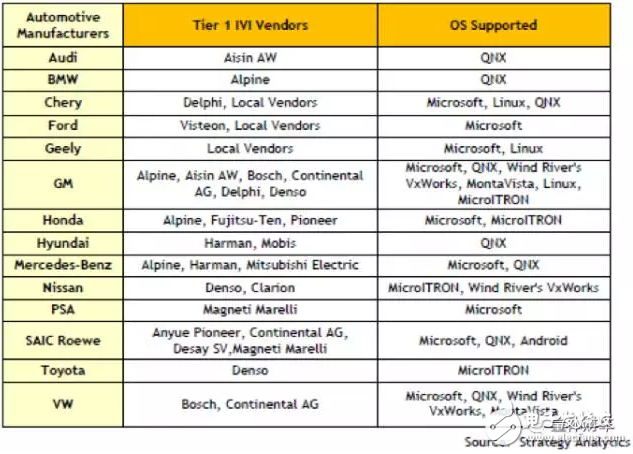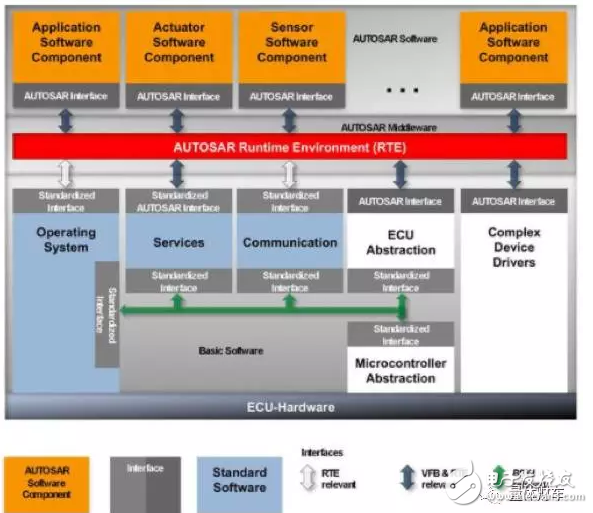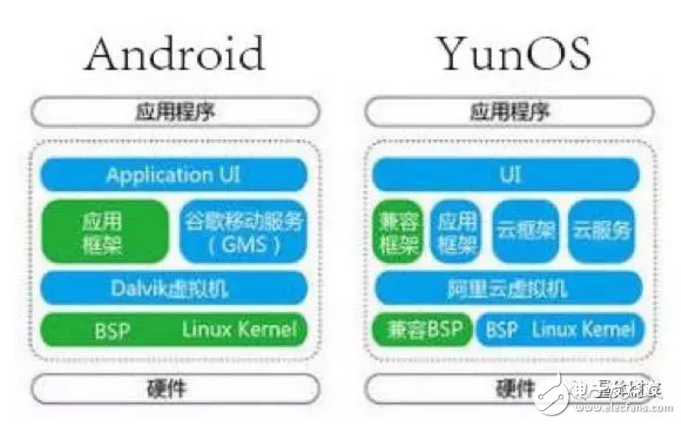With the turn of Alibaba's Alios and Baidu Apollo plans, the "Opera Operating System OperaTIngSystem" seems to be the standard for intelligent networked cars overnight. Is it really the truth? This article will briefly introduce the past and present of the car operating system.
Vehicle system and electronic control systemTo talk about automotive operating systems, you must first understand automotive electronics.
Traditional automotive electronics can be classified into two categories: one is in-vehicle electronic devices, such as meters, entertainment audio, navigation systems, head-up display, vehicle communication, wireless Internet access, etc. These systems are not directly involved in the control decisions of the car, not It has an impact on vehicle driving performance and safety, and is commonly referred to as In-Vehicle Infotainment (IVI).
The other is automotive electronic controls, which are the "brains" of vehicle motion and safety protection that send commands to actuators (such as electronic valves, relay switches, executive motors, etc.) to control critical vehicle components (such as engines, Gearboxes, power batteries, etc. work together. These systems can be collectively referred to as Electronic Control Units (ECUs).
Common ECUs include EMS engine electronic control system, ABS brake anti-lock control, transmission traction control TCU, electronic stability control EPS, electronic power steering EPS, new energy vehicle vehicle control VCU, battery management system BMS.
Why do you need an operating system?Automotive operating systems are an important part of automotive electronics, but not all automotive electronics require an operating system.
Since the 1990s, with the increasing functionality of automotive and electronic control systems and the increasing variety of external interaction/interface standards for automotive electronics, such embedded electronic products based on micro-controllers are increasingly requiring PC-like software. Architecture to achieve tiering, platforming and modularization to increase development efficiency while reducing development costs. Therefore, automotive electronics products have gradually adopted the embedded operating system (EmbeddedOperaTIng System).
Taking the in-vehicle entertainment information system as an example, the earliest digital radio/CD player can be realized by a dedicated audio decoding chip. Later, digitalization will be able to touch the LCD screen instead of the player switch, adjust the button, and later add the Bluetooth phone function. Then integrated map navigation, reversing radar image, the corresponding IVI embedded system main CPU data processing capabilities to achieve these functions are gradually enhanced, from the earliest 4, 8 to 16, 32 to later multi-core, the introduction of embedded The operating system is to effectively allocate CPU resources, coordinate management of the above various task functions, and control the priority level of each task.
Compared with in-vehicle electronic products, electronic control systems usually require closed-loop control, which means that more input and output signals need to be responded to, and task scheduling is more complicated. In addition, since the electronic control system directly participates in the management of vehicle travel, system reliability requirements are required. Higher, so the embedded operating system applied to the electronic control unit ECU has more stringent technical specifications than the operating system of the automotive electronic product.
Car operating system IVI-OSAs early as 2011, the consultancy StrategyAnalyTIcs conducted a survey of China's mainstream auto OEMs and in-vehicle infotainment system vendors, reporting the ecosystem of the in-vehicle operating system at the time, as shown. With the changes in the continued growth of the Chinese automotive market, the report was partially updated in 2015. The current OS for automotive systems on the market includes:
1. Android: Open source operating system, no license fee is very attractive to many low-end car electronics developers, but the version upgrade is too frequent, the boot time is long, the system stability is not strong and has been criticized.
2. Microsoft: From the positioning of industrial applications WinCE to mobile communication Windows Embedded operating system, due to relatively stable performance and peace (Dao) price (Ban) licensing fees, it is highly respected by many companies that have transformed from consumer electronics to the aftermarket. But market share continues to decline.
3. QNX: Once occupied nearly 60% market share, preferential stand-alone licensing fees and good development support are the reasons why mainstream international automotive electronics suppliers are willing to cooperate, but with the decline of their parent company Blackberry and other free competitors The scenery has lost to the same year.
4. Wind River: Powerful to cover multiple real-time operating systems in multiple industries, but licensing and development customization costs are very high and market share is limited.
5. MicroItron: The mainstream automotive operating system for Japanese models, but Japanese suppliers are gradually adopting other OSs to meet the needs of different markets.
6. Linux: Based on open source code, stable and easy to tailor, many R&D auto OEMs and vendors have customized their own operating systems based on Linux.
7. GENIVI: To be precise, it is a standard alliance. The open software platform and operating system for in-vehicle systems established by well-known companies led by BMW, based on the Linux platform, form a closed-loop ecosystem from research and development to application.

As mentioned earlier, the vehicle electronic control system is a complex measurement and control system. If the response of the system task is not timely or the delay is too large, it may cause serious damage. For example, car airbag control, in the short time (milliseconds) of the collision of the vehicle, can not protect the passengers if it cannot be quickly opened.
It can be seen that the automotive electronic control ECU must be a highly stable embedded real-time operating system. The meaning of real-time is that the system guarantees that certain functions are completed within a certain time limit. At present, the mainstream electronic control operating system is basically compatible with the two types of automotive electronic software standards such as OSEK/VDX and AUTOSAR.
1. OSEK/VDX: This standard aims to develop a standardized interface for automotive electronics. It mainly defines three components: real-time operating system (OSEK-OS), communication system (OSEK-COM) and network management system (OSEK-NM). The OSEK operating system began in the 1990s. The first commercial OSEK operating system was developed by 3Soft in Germany and was first applied to the instrument controller of the Audi A8.
2. AUTOSAR: The full name of AUTOSAR is AutomoTIve Open System Architecture, which is literally translated into an automotive open system architecture. Launched in 2003, a standard alliance of global automotive manufacturers, automotive electronics component suppliers, automotive software and tool service providers and semiconductor manufacturers is committed to developing an open, standardized software architecture for the automotive industry. AUTOSAR is compatible with the OSEK/VDX standard, adding a new system module and implicitly proposing the concept of "software-defined electronic control system". As shown in the figure, the complete AUTOSAR system architecture is divided into hardware layer HW and hardware abstraction layer MCAL from bottom to top. The base software layer BSW, the runtime environment RTE and the application software SWC, wherein the operating system is included in the BSW layer.

Regardless of whether it is OSEK or AUTOSAR operating system, they only define the technical specifications of the operating system as a standard. Each software and tool service provider develops its own standard-compliant operating system products, and then provides them to Tier1 suppliers for a wide range of applications. Control system.
At present, AUTOSAR has gradually become the mainstream. The well-known companies with complete solutions in the market include Vector, KPIT, ETAS, DS and the acquired EB (Continental) and Mentor Graphics (Siemens). In China, relying on the national “nuclear high-base†project, i-Soft has also developed an operating system and basic software that conforms to the AUTOSAR standard, and has successfully applied it to its own brands and new energy production models.
Intelligent Networking's new requirements for operating systemsIntelligent networked cars are characterized by the addition of more intelligent sensors (high-definition cameras, lidars, millimeter-wave radars, etc.) and the need to collect, process and share massive amounts of data.
To achieve intelligent network connection, two basic problems need to be solved: one is the processing power of the controller chip, and the other is information security. To this end, Tier1, headed by Bosch, Continental, and Delphi, proposed the concept of a Domain Controller (DCU), which divided the entire vehicle into a powertrain, vehicle safety, body electronics, smart cockpit and Several domains, such as smart driving, use a more powerful multi-core CPU/GPU chip to control each domain relatively centrally to replace the current distributed automotive electrical and electronic architecture (EEA).
Although such a design simplifies the topology of the automotive electronic network, it also poses a security risk due to the integration of various data. For example, the intelligent cockpit system ECU combines the original in-vehicle infotainment system with V2X, HMI, instrumentation and other data, but according to the functional safety ISO26262 standard, certain key data and codes of the instrument and the HMI code belong to different levels. Requirements (ASIL) should be physically isolated from a security perspective. Therefore, such a design runs counter to the safety standards of automotive electronic functions.
How to solve it? With the integration of automotive electronic safety components such as IVI systems and other non-security components in intelligent networked vehicles, automotive electronics experts have introduced the concept of virtual machine management in avionics. Based on the AUTOSAR standard, AUTOSAR Hypervior is proposed. Virtual machines, the new AUTOSAR Adaptive Platform version has also been extended to intelligent network and autonomous vehicles.
The key to introducing virtual machine management is that the virtual machine can provide an environment that runs two independent operating systems at the same time, such as running Android (vehicle function) and QNX (electric control function) in the smart cockpit ECU for intelligent network application. Provide a platform that is cost effective and meets security requirements.
Currently commercial products for automotive hypervisors include Blackberry QNX Hypervisor, Wind River VxWorks, Green Hills INTEGRITY Muitivisor, Mentor Graphics Embedded Hypervisor and OpenSynergy acquired by Panasonic Automotive last year.
Can Alios of Alibaba drive car intelligence?Alios has been renamed by YunOS. The debate about whether YunOS is Android or not is actually not important. In any case, at least typical Chinese innovation. In the smartphone market, Ali is expanding the market share of YunOS in mobile devices. Alibaba's strategy is to cooperate with third-line self-branded mobile phones to subsidize the pre-installed YunOS mobile phones; afterwards, turn to the automotive market, Ali from SAIC's own brand cooperation has tasted the sweetness and began to force Alios into a car network operating system.

However, for the car, Alios can only be called the car operating system for the time being. Can it drive the car intelligence? In my opinion:
First, Alios' current competitors are still in-car operating systems such as Google Android, Apple IOS and Baidu DuerOS. The advantage is that Alios has added cloud service-related modules to access Alibaba's ecosystem, with emphasis on e-commerce ( Taobao), online payment (Alipay) and HD map (Gao De) to create a second mobile payment terminal in addition to mobile phones.
Second, with the upgrade of the intelligent network system
Type2 Tethered Cable,Tethered Cable,Tethered Type 2 Cable,Type 2 Tethered Charging Cable
Yangzhou JERI New Energy Co., Ltd. , https://www.jrevcharging.com